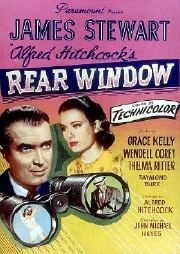
Sound design in 'Rear Window'One of the earliest films to make an attempt to do this was Disney's Bambi (1942): the famous scene in which Bambi's mother is shot ('Your mother can't be with you any more' - not a dry eye in the house) is enhanced by the balance of the speech in the studio acoustic.  But
probably the first film to make a serious effort in the design of the sound was
Hitchcock's Rear Window (1954): almost the whole film is
shot from the viewpoint of James Stewart, trapped in his apartment with a broken
leg and taking a voyeuristic interest in the occupants of the various apartments
he can see round the large courtyard of the building. All through the film we
can hear sounds and voices from these apartments in the distance, carefully
balanced to sound realistic and - as would be the case in real life - none too
clear: however essential lines of dialogue from these characters are always
intelligible. It's a sophisticated and very clever piece of sound mixing: it
would be another twenty years before this sort of concept became more
widespread. The sound recording is credited to Harry Lindgren and John Cope: the
mixer was not credited but was Loren L. Ryder who was nominated for an Oscar
for this film (though it was actually won by
Oklahoma!). But
probably the first film to make a serious effort in the design of the sound was
Hitchcock's Rear Window (1954): almost the whole film is
shot from the viewpoint of James Stewart, trapped in his apartment with a broken
leg and taking a voyeuristic interest in the occupants of the various apartments
he can see round the large courtyard of the building. All through the film we
can hear sounds and voices from these apartments in the distance, carefully
balanced to sound realistic and - as would be the case in real life - none too
clear: however essential lines of dialogue from these characters are always
intelligible. It's a sophisticated and very clever piece of sound mixing: it
would be another twenty years before this sort of concept became more
widespread. The sound recording is credited to Harry Lindgren and John Cope: the
mixer was not credited but was Loren L. Ryder who was nominated for an Oscar
for this film (though it was actually won by
Oklahoma!).A bit off the subject, but to nail one myth: almost every reference you see about this film will tell you that it is entirely shot from inside Stewart's apartment, right up to close to the end when he falls out of the window: this is shot upwards from ground level outside the room. There is, however, and rather oddly, one shot prior to this which is clearly shot at ground level in the courtyard, a reverse angle close-up of one of the peripheral characters. (There are also several less obvious shots from ground level - and of Stewart's apartment from outside his window.) Why Hitchcock - who never did anything accidentally - should break his rule in this way is a mystery. Watch out for the close-up next time you see the film - it's gone in a flash. Posted: Mon - July 28, 2008 at 09:16 AM by Roger Wilmut |
Quick Links
About Me:
Roger Wilmut XML/RSS Feed
MY PODCAST
Archives
Calendar
Blogroll
WEBRINGS
Statistics
Total entries in this category: Published On: Mar 11, 2016 05:00 PM |
||||||||||||||||||


